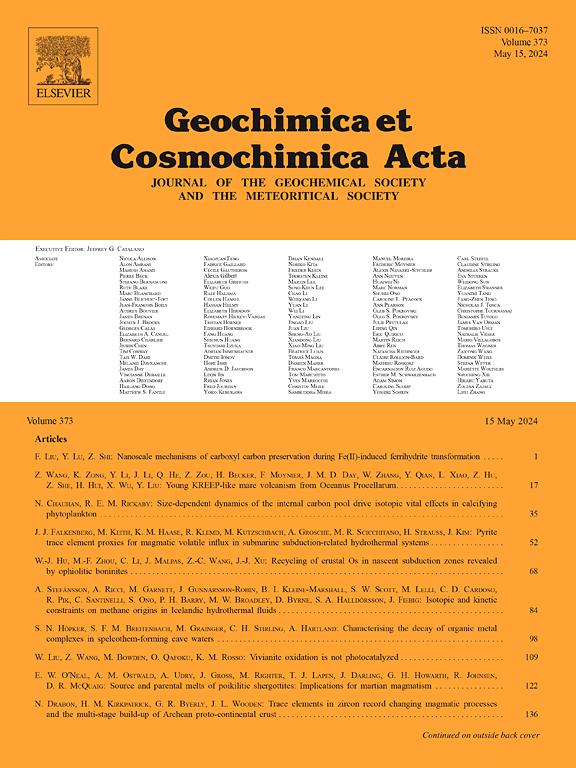风化和再循环对稀土元素行为的控制:花岗岩、玄武岩和风成红壤结壳的比较研究
IF 5
1区 地球科学
Q1 GEOCHEMISTRY & GEOPHYSICS
引用次数: 0
摘要
强烈的化学风化作用和沉积再循环作用在华南地区形成了广泛的富ree红壤结壳。本研究比较了三种具有代表性的风化层类型:花岗岩(YQ)、玄武岩(ZJ)和风成红土(LZ)的稀土分馏和迁移率。总REE浓度顺序为:YQ(512±66 ppm) >;ZJ(153±38 ppm) >;LZ(82±35 ppm)。YQ剖面富集轻稀土元素(LREE),重稀土元素(HREE)在硅酸盐分解过程中更容易浸出。相比之下,富含Fe-Mn(水)氧化物的ZJ剖面由于氧化还原敏感的矿物转化和表面络合作用,保留了中间REE (MREE),但表现出LREE的耗尽。LZ剖面稀土元素总量最低,但稀土元素相对富集,反映了石英贫化和锆石等难熔碎屑矿物富集的综合作用。除岩性和气候外,稀土元素组成还受粒度、风化强度和矿物学变化的影响,这些因素共同调节着风化岩系统中稀土元素的吸附和再分配过程。研究结果揭示了热带和亚热带环境稀土元素分异机制,建立了地球化学框架。本文章由计算机程序翻译,如有差异,请以英文原文为准。
Weathering and recycling controls on rare earth element behavior: A comparative study on granitic, basaltic and aeolian red soil crusts
Intense chemical weathering and sedimentary recycling have produced widespread REE-enriched red soil crusts in South China. This study compares REE fractionation and mobility across three representative regolith types: granitic (YQ), basaltic (ZJ), and aeolian lateritic (LZ). Total REE concentrations follow the order of YQ (512 ± 66 ppm) > ZJ (153 ± 38 ppm) > LZ (82 ± 35 ppm). The YQ profile is enriched in light REE (LREE), while heavy REE (HREE) are more readily leached during silicate decomposition. In contrast, the ZJ profile—rich in Fe–Mn (hydr)oxides—retains middle REE (MREE) due to redox-sensitive mineral transformations and surface complexation, but exhibits LREE depletion. The LZ profile shows the lowest total REE, but is relative enriched in HREE, reflecting the combined effects of quartz dilution and the accumulation of refractory detrital minerals such as zircon. Beyond lithology and climate, REE compositions are modulated by grain size, weathering intensity, and mineralogical variance, which jointly regulate REE adsorption and redistribution processes in regolith-hosted systems. Our results provide mechanistic insights into REE differentiation and establish a geochemical framework for REE exploration in tropical and subtropical environments.
求助全文
通过发布文献求助,成功后即可免费获取论文全文。
去求助
来源期刊

Geochimica et Cosmochimica Acta
地学-地球化学与地球物理
CiteScore
9.60
自引率
14.00%
发文量
437
审稿时长
6 months
期刊介绍:
Geochimica et Cosmochimica Acta publishes research papers in a wide range of subjects in terrestrial geochemistry, meteoritics, and planetary geochemistry. The scope of the journal includes:
1). Physical chemistry of gases, aqueous solutions, glasses, and crystalline solids
2). Igneous and metamorphic petrology
3). Chemical processes in the atmosphere, hydrosphere, biosphere, and lithosphere of the Earth
4). Organic geochemistry
5). Isotope geochemistry
6). Meteoritics and meteorite impacts
7). Lunar science; and
8). Planetary geochemistry.
 求助内容:
求助内容: 应助结果提醒方式:
应助结果提醒方式:


